Over the past few years a slew of news outlets have been singing the cognitive benefits of learning to juggle. If one is to believe the hype, this ancient circus activity will increase your brain power, make your brain bigger (permanently, no less), and may even prevent Alzheimer’s disease. Dang.
Can there be any truth to these heady claims, or is it another case of the media committing that most egregious of sins: distorting science for the sake of a catchy headline? Here we plunge into the literature and investigate what has actually been shown experimentally. And right off the bat, no, the Alzheimer’s has never been studied in relation to juggling.
1. Shades of grey matter
The study that set off this whole chain reaction of neuro-juggling interest was a 2004 Nature paper by a German group. The researchers scanned 24 young people’s brains using MRI (which I’ve described previously), and half the participants were then given three months to learn to juggle the three-ball cascade. Everyone was scanned again, then juggling was prohibited for three months until a final scan was taken.
The authors found that the brains of people in the juggling group:
“…showed a transient and selective structural change in brain areas that are associated with the processing and storage of complex visual motion.”
If you’re sciencey, the specific regions were the bilateral mid-temporal hMT/V5 areas and the left posterior intraparietal sulcus.
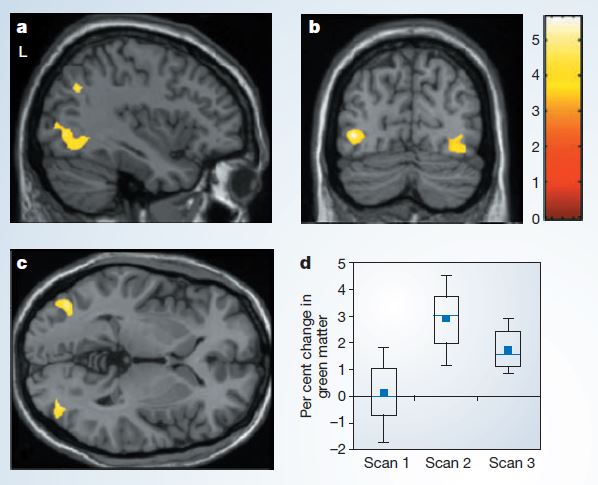
Draganski et al. 2004
The heat map indicates Z scores, i.e. the changes were very statistically significant, and tightly restricted to hMT/V5 and the left posterior intraparietal sulcus. Figure d) shows that the increase in grey matter after three months of juggling was ~3%. About half of this was lost after three months without practice.
Interestingly, the altered regions are associated with visual processing, not motor control as might be expected. Possibly this is because humans are naturally perfectly adept at operating their limbs, but less so at tracking multiple rapidly moving objects. The authors also stressed that it’s unknown whether the changes in grey matter correspond to increased cell/synapse volume or new cell growth (though some evidence suggests synapse volume is mostly responsible).
In a subsequent study the same group found that the original period of learning to juggle involves a grey matter increase, but once training is stopped the brain slowly returns to more or less its original shape – even in people who retain the ability to juggle. Any physical changes that do persist are subtle and don’t change the net size-weight of the brain.
Returning to our earlier media claims, what does this research tell us about juggling’s effect on brain power? Rather little. All it shows is that when you learn to juggle, there is a corresponding structural change in the brain. It’s not necessarily useful for anything other than juggling, and maybe learning any new skill causes a structural change.
How about brain size? No, it doesn’t increase. Is the change permanent? No, 50% of grey matter gain is lost after three months without practice. Similarly, many participants forgot how to juggle in this time. If anything, the evidence we’re left with points to the old maxim: use it or lose. Maybe you can forget how to ride a bike after all.
2. Teaching an old dog new (juggling) tricks
While grey matter increases with juggling practice, sadly it also decreases with age. To see whether the same neural flexibility exists in older individuals, the German researchers repeated their procedure in people aged around 60. This cohort fared much worse than the youngins at learning to juggle, with only a quarter becoming fluent in the cascade. However, amongst those who did succeed the degree of grey matter increase was similar to that seen in the original study.
Interestingly, the older group also saw increases in grey matter density in the left hippocampus and nucleus accumbens. The hippocampus is known to be one of the very few brain regions to give birth to new neurons, generally in response to exercise or environmental stimulus. Juggling arguably ticks both these criteria. As for the nucleus accumbens, this is involved in sense of reward, and mastering a new skill is certainly rewarding. The nucleus accumbens links the limbic and motor systems, converting reward signals into motivation to act – perhaps in this case, to keep juggling.
These all suggests that practising a complex new skill such as juggling can be just as beneficial for older individuals as younger ones, if not more so. Whatever your age though, neglect your practice and any changes seem to soon disappear.
3. Into the white
If grey matter is the brain’s computing infrastructure, white matter is the fibre optic cables (myelinated neural axons) that link everything up and determine how quickly communications happen. In the case of juggling, grey matter might help your hands get into just the right place, but white matter controls how quickly they can get there (more or less).
In 2009, a group of researchers from the UK published a paper in Nature Neuroscience demonstrating for the first time that training a physical skill, juggling, can increase not only grey matter but also white matter, in this case by about 6% in a region called the right posterior intraparietal sulcus. Fittingly, this structure is involved in arm movement, grasping and tracking in peripheral vision, and is important for planning and executing complex movements.

POS = parieto-occipital sulcus. IPS = intraparietal sulcus. FA = fractional anisotropy, a measure of white matter connectivity. Schulz et al., 2009
The UK group also observed grey matter changes in regions matching those found by the German group, adjacent to where the white matter increases were. Unlike the German studies, they conducted their final scan only four weeks after juggling practice ended. While they didn’t see any reversion of the changes in this time, it’s possible this would still occur after three months.
The biological significance of white matter increase is harder to pin down, however it is thought to affect neural signalling speed and synchronization. The grey and white matter changes occurred independently of each other, and there was no strong relationship between either degree of change with level of juggling skill obtained. This supports the idea that structural change has more to do with time invested than absolute skill.
Dr Johansen-Berg, the leader of the study pointed out, “Of course, this doesn’t mean that everyone should go out and start juggling to improve their brains. We chose juggling purely as a complex new skill for people to learn. But there is a ‘use it or lose it’ school of thought, in which any way of keeping the brain working is a good thing, such as going for a walk or doing a crossword.”
4. Bring in the professionals

So far we’ve only considered people who’ve juggled for a few weeks or months. What happens to the brain though after years of juggling practice? Do white and grey matter density increase even further? Or do they decline? Are the same brain regions recruited or novel ones?
To answer these questions, another team of researchers from Germany compared the brains of non-jugglers with seasoned experts who could juggle not just the three- but five-ball cascade. To mix it up, let’s jump into a list to summarise these findings:
- Both groups had the same total white and grey matter volume. Juggling most certainly does not make your brain bigger.
- As with earlier studies, jugglers had significantly higher grey matter density in the hMT/V5 and intraparietal sulcus.
- While these are the same areas that are increased in density in newly practising jugglers, the mechanisms might be different. For example, new jugglers’ brains might rely on rapid processes like increased blood flow or glial swelling, whereas long-term jugglers’ brains may have formed new synapses and vasculature.
- Expert jugglers also had greater grey matter in the lingual gyrus/V2 and left-hemisphere motor areas of BA 6 and BA 9.
- Cells in the V2 region process binocular disparity, thereby coding an object’s depth in space. This may come into play with more complex juggling tricks.
- Juggling skill was only correlated with grey matter density in the right hMT/V5 area, the same region identified in the original 2004 study. This is therefore the Almighty Juggling Patch of the brain.
5. Should we give a toss?
We’ve gone on at length about the various brain structure changes that juggling causes, how persistent they are and to what degree they correlate with skill. But coming back to the original media claims, does any of it matter? Does learning to juggle make you smarter in any useful sense, or just make you better at juggling?
Despite the widespread enthusiasm, unfortunately juggling is not special. If we look at the brains of people who’ve practised a different physical activity – say, being a world class gymnast – it turns their brains are just as altered. In fact, much more so.
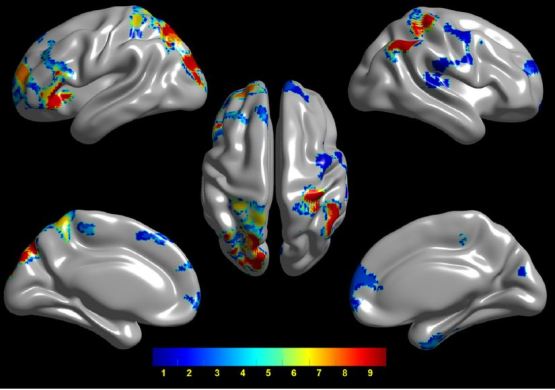
Just look at all those colourful gymnasticky patches. Huang et al., 2015
To change the structure of your brain, you don’t even have to practice a physical skill. Want to increase the white matter connectivity between your two hemispheres? Just learn Chinese! In fact, a skill doesn’t even need to have a shred of real-world usefulness for it to change your brain. You can increase grey matter density in your hippocampus, prefrontal cortex and cerebellum by – wait for it – playing Super Mario 64. Yes, Super Mario.
However, the transferability of skills should not be underestimated. For example, in one study, juggling practice made participants better at a mental rotation task, providing direct evidence of a connection between a motor skill and spatial ability. Another study found that baseline grey matter volume in several areas (including V1, V2, V4 and precuneus) predicted the speed with which individuals could learn juggling.
In summary, your brain is an ever-changing, electrically crackling ball of mystery and wonder. It is entirely possible to train it and re-shape it, and in fact you can’t stop doing this by merely living life. The catch though is that, at least at this point in time, it’s practically impossible to know what aptitudes you’re training when, or which regions are co-opted for seemingly unrelated tasks.
So, juggling. It may not make your brain bigger, or more powerful, or protect you from Alzheimer’s. But it’s a fun, portable and surprisingly absorbing activity that will give you some exercise and yes, change your brain. But then, so will everything you do.
* * *
Postscript: If you do decide to try out juggling (and you should!), it turns out you really don’t need to spend long on it each day. A 2014 study took a bunch of juggling novices and divided them into high and low intensity groups, meaning they had to spend either 30 or 15 minutes per day practising. Both groups progressed at the same rate, after a month there was no difference in ability between the two, and after stopping they declined in ability at the same rate. A testament to the futility of cramming when it comes to learning, as we’ve discussed previously!
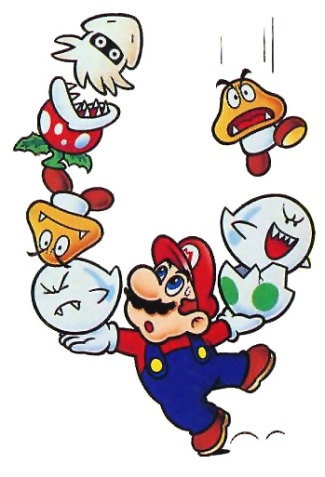
Peer-reviewed Sources
- 2003 Resnick et al – Longitudinal magnetic resonance imaging studies of older adults: a shrinking brain.
- 2004 Draganski et al – Neuroplasticity- Changes in grey matter induced by training
- 2008 Boyke et al – Training-Induced Brain Structure Changes in the Elderly
- 2008 Driemeyer et al – Changes in Gray Matter Induced by Learning—Revisited
- 2009 Scholz et al – Training induces changes in white-matter architecture
- 2011 Jansen et al – The influence of juggling on mental rotation performance in children
- 2012 Schlegel et al – White Matter Structure Changes as Adults Learn a Second Language
- 2013 Kuhn et al – Playing Super Mario induces structural brain plasticity
- 2014 Gerber et al – Juggling revisited — A voxel-based morphometry study with expert jugglers
- 2014 Sampaio-Baptista et al – Gray matter volume is associated with rate of subsequent skill learning after a long term training intervention
- 2015 Huang et al – Long-term intensive training induced brain structural changes in world class gymnasts
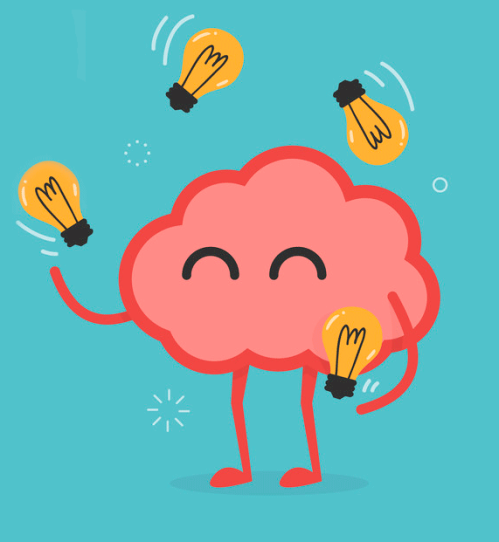
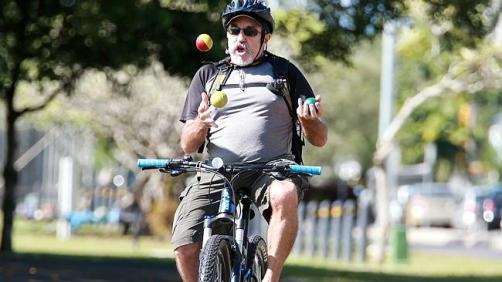
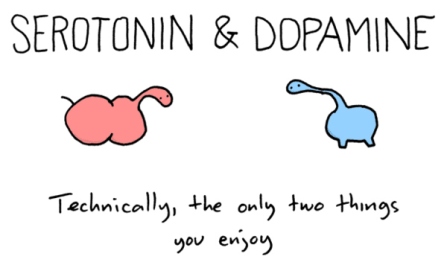
“havae yoo got any pwear reciewead referencae ”
I can easily envision a couch potato uttering these reddit-tier comments, probably in sweats, while chomping on some good ole’ cheetos.
I can almost guarantee you can’t take a shit without some “peer reviewed” bullshit telling you what’s the best position to do so.
And that you still have your pfizer booster scheduled.
LOL. Touch some grass, dude. Quit the faggotry. Put in some real work. Your “reference” will be yourself.
Pingback: 11 fatos inesperados sobre o circo que são contados apenas nos bastidores - Vejaki - Um mundo de curiosidade
Pingback: Brain Benefits From Juggling May Be Under Or Overestimated | By Dr. Patricia Farrell | BeingWell | Dec, 2020 - NewsProPlus.com
This article doesn’t seem to give correct picture of possible benefits.
Studies may not capture improvements just by looking at brain’s structural changes.
You also need to assess people on various other aspects as well, like reading speed, writing speed, etc.
All get improved significantly!
That’s super interesting if true, I didn’t come across any literature about that. Have you got a reference I could check out?
I taught juggling in my elementary school physical education classes for almost 30 years and it proved to be a beneficial activity for all of my students!! I achieved a success rate of over 80% at juggling 3 scarves and over 25% at juggling 3 bean bags!! With 4th and 5th grade students, those percentages were much higher!!
Dear Richard,
I would be glad to hear about it more. I am psychologist, and there is a course for us: Juggling and ADHD. I would like to take part as soon as Covid makes it possible. I am from Hungary. I would be pleased to change email address with you. csullagkata@gmail.com
Thank you! I’ve been looking everywhere and this is by far the best article I’ve found on this subject. I would argue that some of the comparisons at the end are slightly unfair. Everything can change your brain yes, but not everything will change it in a positive way. Playing Super Mario 64 may seem silly, but it’s also a challenging and complex activity. I’m not surprised that it also brings some benefits. And I’m sure learning Chinese or becoming a world-class gymnast is even more beneficial, but I doubt that it can be done in just 6 weeks of fun 15 minutes a day practices.
Unimportant side note: I wish I could have coached those 60 years old and see if I can turn that 25% success rate into 100%. I bet I could!
Pingback: Top Novels of the 20th Century: the Internet’s Foxiest Guide Yet | Trading Atoms